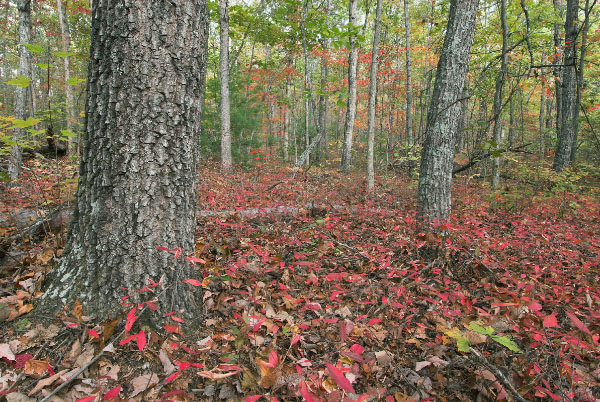
 إدارة الحفاظ على البيئة والترفيه
إدارة الحفاظ على البيئة والترفيه احفظ. احمِ. استمتع.
 إدارة الحفاظ على البيئة والترفيه
إدارة الحفاظ على البيئة والترفيه  جدول المحتويات
جدول المحتوياتغابات البلوط/غابات البلوط
This group of oak-dominated forests is prevalent on xeric, infertile upland sites in every physiographic province of Virginia, and is wide-ranging in the Appalachians and adjacent provinces outside of the Commonwealth. In some cases, particularly in the mountains and foothills, these communities have replaced former mixed oak - American chestnut (Castanea dentata) forests following the decimation of chestnut overstory trees by an introduced fungal blight (Cryphonectria parasitica) early in the twentieth century. Habitats are variable, ranging from sterile, low-elevation "flatwoods" to steep, rocky mountainsides. All have soils with a distinctly oligotrophic nutrient regime, i.e., strongly acidic, with low base cation levels and relatively high levels of iron. Accumulations of thick duff and high biomass of inflammable shrubs in these forests make them susceptible to periodic fires, which in turn favors recruitment of oaks. Regionally varying mixtures of white oak (Quercus alba), chestnut oak (Quercus montana), scarlet oak (Quercus coccinea), black oak (Quercus velutina), northern red oak (Quercus rubra), southern red oak (Quercus falcata), and post oak (Quercus stellata) compose the overstories of these forests. Bigtooth aspen (Populus grandidentata) and pines - including pitch pine (Pinus rigida) in the mountains, shortleaf and Virginia pines (Pinus echinata and Pinus virginiana) in the Piedmont, and loblolly pine (Pinus taeda) in the Coastal Plain - are common associates that usually indicate past disturbance. Hickories (Carya spp.) are generally unimportant and, when present, mostly restricted to the understory.

Forests overwhelmingly dominated by chestnut oak (Quercus montana, = Quercus prinus) are widespread on sandstone or quartzite ridges in the mountains, but occur locally on monadnocks, foothills, and rocky or gravelly bluffs throughout the Piedmont and inner Coastal Plain. On gentler, low-elevation terrain of eastern Virginia and the mountain valleys, white oak is more prominent in mixtures with several other oaks. Blackgum (Nyssa sylvatica) and sourwood (Oxydendrum arboreum) are frequent overstory associates and abundant understory trees, along with sassafras (Sassafras albidum) and downy serviceberry (Amelanchier arborea). Decades of fire suppression or exclusion has led to a general abundance of the fire-intolerant red maple (Acer rubrum) in oak / heath forest understories. Ericaceous (heath-family) plants, including mountain laurel (Kalmia latifolia), black huckleberry (Gaylussacia baccata), wild azalea (Rhododendron periclymenoides), and blueberries (Vaccinium spp.), form dense colonies in the shrub and herb layers. Evergreen rhododendrons (Rhododendron maximum and Rhododendron catawbiense) and flame azalea (Rhododendron calendulaceum) are locally prevalent members of the ericaceous shrub complex in the mountains, while dangleberry (Gaylussacia frondosa) is a prominent ericad in the Coastal Plain. The ericaceous sub-shrubs trailing arbutus (Epigaea repens) and wintergreen (Gaultheria procumbens) may also be abundant, especially in the mountains. The density of ericaceous species may be closely tied to land-use and disturbance history. True herbaceous species are sparse, but may include scattered individuals or colonies of xerophytes such as galax (Galax urceolata), yellow wild indigo (Baptisia tinctoria), pink lady's-slipper (Cypripedium acaule), dwarf iris (Iris verna), large whorled pogonia (Isotria verticillata), cancer-root (Orobanche uniflora), gaywings (Polygaloides paucifolia), eastern bracken fern (Pteridium aquilinum ssp. latiusculum), and Virginia goat's-rue (Tephrosia virginiana).
وتشكل أنواع المجتمعات في هذه المجموعة عنصراً واسع الانتشار من النباتات المصفوفة أو النباتات ذات الرقعة الكبيرة في المناظر الطبيعية في فرجينيا. على الرغم من أنها لا تزال واسعة النطاق نسبياً، إلا أنها تتعرض للعديد من الاضطرابات، بما في ذلك قطع الأشجار وتحويلها إلى مزارع الصنوبر، وإبادة عثة الغجر، وإخماد الحرائق، والتدمير بسبب التنمية. ومع ذلك، فقد نجا عدد من حوامل أشجار البلوط الكستنائي التي يهيمن عليها البلوط الكستنائي على التلال الجبلية الجافة في فيرجينيا من القطع بسبب النمو المتقزم والشكل الضعيف للأشجار العلوية.
المراجع: أبرامز وآخرون . (1997)، آدامز وستيفنسون (1983)، ألارد وليونارد (1943)، كلارك ووير (1980)، كول ووير (1997)، كولينج وروينسكي (1999)، كراوتش (1990)، فاريل ووير (1988)، فليمنج (2002أ ), فليمنج (2002ب )، فليمنج (2007)، فليمنج وكولينج (2001)، فليمنج ومورهيد (1996)، فليمنج ومورهيد (2000)، فليمنج وويبر (2003)، جيمبوريس (1974)، هاريسون وآخرون . (1989)، وجونسون ووير (1982)، ومارتن وآخرون . (1982)، ماكوي وفليمنج (2000)، ماكيفوي وآخرون . (1980)، أولسون وهوب (1986)، أورويغ وأبرامز (1994)، روينسكي وآخرون . (1994)، روينسكي وآخرون . 1991(1996)، رودس (1992)، رودس (1995)، رودس (2002)، ستيفنسون (1974)، ستيفنسون (1982أ )، ستيفنسون وآدمز (1991)، ستيفنسون وفورتني (1998)، فانديرهورست (2000)، والتون وآخرون (2001)، وير ( 0 ).انقر هنا لمزيد من الصور لهذه المجموعة المجتمعية البيئية.
 © دى سى آر دى إن إتشه، غاري ب. فليمنغ
© دى سى آر دى إن إتشه، غاري ب. فليمنغ
وقد تم أخذ عينات من أكثر من 300 قطعة أرض من هذا الغطاء النباتي في فيرجينيا (الشكل 1)، وتم تصنيف تسعة أنواع من المجتمعات المحلية في سياق العديد من التحليلات الإقليمية. تتميز معظم هذه الوحدات الدقيقة المستوى بوضوح بتدرجات جغرافية/ارتفاعية قوية واختلافات نباتية مرتبطة بها. ومع ذلك، فإن الفصل المفترض بين "وسط الأبلاش" و "وحدات الأبلاش الجنوبية" إشكالية بشكل خاص في غرب فرجينيا، حيث غالباً ما تندمج نباتات هذه المناطق البيوجغرافية الحيوية بشكل غير محسوس. انقر على أي رمز من رموز CEGL المميزة أدناه لعرض الوصف العالمي لسلسلة القيمة العالمية للنباتات في الولايات المتحدة الأمريكية المقدم من مستكشف خدمة 
 الطبيعة. قم بتنزيل جدول بيانات لإحصائيات ملخص التركيب لكل نوع من أنواع المجتمعات المدرجة أدناه.
الطبيعة. قم بتنزيل جدول بيانات لإحصائيات ملخص التركيب لكل نوع من أنواع المجتمعات المدرجة أدناه.

